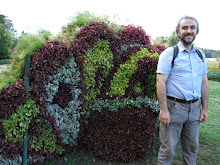
1. gilding
A piece detached from the shadow
is this untouched stone over which
eagles stretch out their wings,
here is where the traces of the stakes
upon which we have impaled our song
fade out.
Death pours into our palms
like a clear water
in which we see our faces,
somewhere stunningly close
a virgin word flutters.
The breathing creases up the marble stone,
the word is sharpened up by wounds
and grows in between us like a cutting edge
which we gild with our knees.
2. sketch
knife thrust into death,
the grieved light caressing my fist-size wounds
through which I breathe out
forgiveness
under the collapsed scaffolds
some sketches, discolored by rain, lay trembling...
3. retouch
We’ve been left alone on this road
as if we put on the outfit of senses inside out,
so many wounded smiles lay shelterless,
encircled by water we overflow,
bearing the body inside like a seed.
The silence sings, opening up an inner eye into each thing,
from your deserted name an angel speaks to me:
its wings weeping upon the halo of its moneyless hands,
he retouches the outline of the rain-washed shadows.
We are mocking the toothless death, cleaning up our wounds
with the flame that seeks us behind closed doors.
(poem published in the volume "catacombe. aici totul e viu" ("catacombs. everything is alive here"), Vinea Publishing House, Bucharest, 2008, pp. 16-17. English translation: Simona Sumanaru.)




